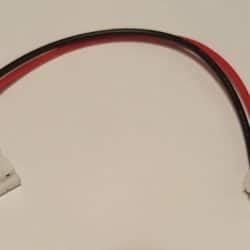Home › Forums › Mayfly Data Logger › Powering an Adafruit FONA › Reply To: Powering an Adafruit FONA
The SIM808 module on the FONA must be powered directly from a 3.7v LiPo battery because it draws around 500mA during data operation, and can have occasional draw of up to 2 amps during a TX burst. The SIM808 module also requires a power source of 4.0v nominal, with a minimum of 3.4v and a max of 4.4v. So powering it directly from a 3.7v Lipo is the only reasonable option.
This is the reason there are two JST “LiPo Batt” jacks on the Mayfly. If you want to use a FONA with a Mayfly, you’ll need to connect a LiPo battery directly to one of the JST jacks labeled “LiPo” on the Mayfy. Then use a JST jumper to connect the JST jack on the FONA’s to the Mayfly’s other “LiPo” jack.
I’ve attached a picture of a JST jumper. We use GPRSbee cellular modules with almost all of our deployments and they come with one of these jumpers. You can make you own jumper by splicing together 2 standard JST pigtail cables.
Be sure to connect the “Vio” pin on the FONA to the 3.3v rail of the Mayfly in order to properly configure the logic level shifting of the FONA’s circuitry.
If you’re looking for the easiest 2G option, I highly recommend the GPRSbee (https://shop.sodaq.com/en/gprsbee.html). It plugs directly into the Bee socket on the Mayfly. Just add the JST power jumper and the u.fl antenna (included) and it’s ready to go. I’ve been using dozens of them for several years now and I really like them.

 Welcome to EnviroDIY, a community for do-it-yourself environmental science and monitoring. EnviroDIY is part of
Welcome to EnviroDIY, a community for do-it-yourself environmental science and monitoring. EnviroDIY is part of 